
26/12/10
Luis Peso: Winner of Autodesk SketchBook Hero Image Contest

The Fifth Annual Foam Magazine Talent Call

Abitare: 50 Years of Design

Healthcare Spaces 5

Smartstand Digital Music Stand: Learn Music Faster
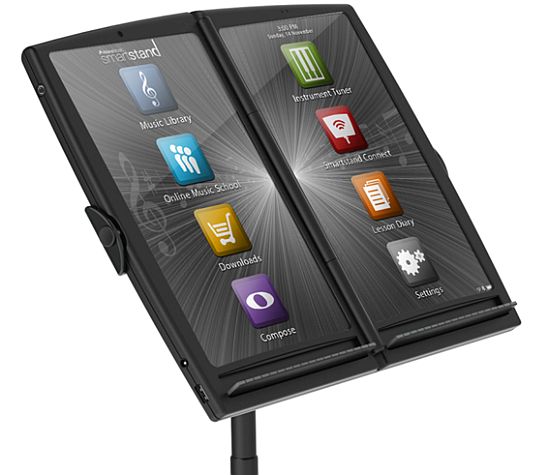 The Smartstand digital music stand is a portable stand that displays sheet music: at its core, this seems to be the major objective. This saves paper, and also saves from having the musician turn the page — which seems to be a nuisance for many musicians (myself included – I considered myself fortunate I wasn’t playing tuba and didn’t have to navigate clumsily to the stand with that gigantic instrument in my lap). Instead, there is a pedal where a musician can tap his/her foot on, and the page will turn.
The Smartstand digital music stand is a portable stand that displays sheet music: at its core, this seems to be the major objective. This saves paper, and also saves from having the musician turn the page — which seems to be a nuisance for many musicians (myself included – I considered myself fortunate I wasn’t playing tuba and didn’t have to navigate clumsily to the stand with that gigantic instrument in my lap). Instead, there is a pedal where a musician can tap his/her foot on, and the page will turn. 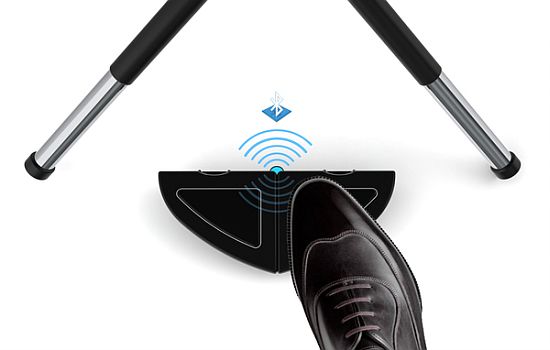 Although that’s dandy and everything, simply turning a page is just the beginning. I think the potential lies in music tuning, which seems to be one of the features it has (from what I see in one of those images above, it is an option). With this feature, when warming up, musicians can tune their instruments correctly; in the future, perhaps a feature could be implemented where it can preview the song as well, so amateur musicians can have an idea of how the song is supposed to sound before playing it for the first time.
Although that’s dandy and everything, simply turning a page is just the beginning. I think the potential lies in music tuning, which seems to be one of the features it has (from what I see in one of those images above, it is an option). With this feature, when warming up, musicians can tune their instruments correctly; in the future, perhaps a feature could be implemented where it can preview the song as well, so amateur musicians can have an idea of how the song is supposed to sound before playing it for the first time. 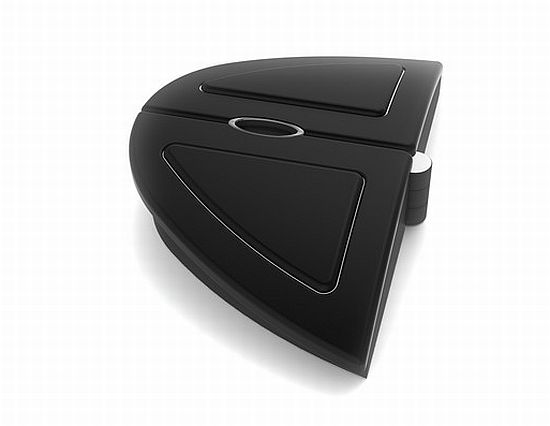
Celcius X VI II LeDIX Origine : A Clamshell Cell Phone With An Integrated Tourbillion Watch
Limited Edition LeDIX Origine is the ultimate expression of contemporary elegance. LeDix Origine combines a pocket watch and mobile phone into a luxurious object that pushes the boundaries of imagination. It is made from polished and brushed grade 5 titanium discreetly enhanced by solid ebony wood inserts.
The classic dial features polished and brushed-finish Black Gold and proudly bears the °C of Celsius X VI II. It also has a visual “optical illusion” type surprise in store for observers, since when viewed from a different angle, the 0-3-9 indexes reveal three-dimensional numerals.
The timeless keypad is made of 21 keys and one single sapphire crystal plate. It is available in Latin, Arabic, Chinese or Cyrillic.
Designer : Celcius X VI II
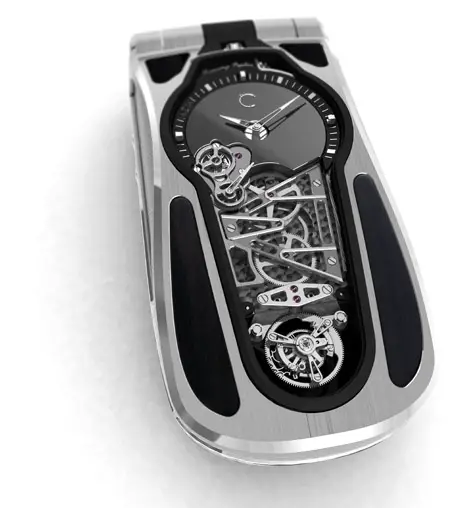
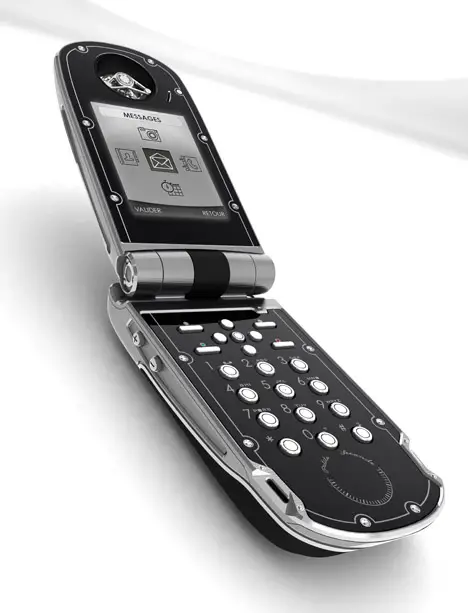
Whilst communicating has become a detached commodity induced by the transformation of the traditional pen and paper into disposable computers and phones, Celsius X VI II innovates to create functional “Objets d’Art” that bring emotions back to communication.
Like a butterfly spreading its wings, LeDIX, the first creation from Celsius X VI II, has taken flight after four years of research and development. Is it a pocketphone-watch or a watch cell phone? It is above all a resolutely novel nomadic object that pushes the boundaries of imagination.
At first glance, LeDIX is a clamshell cell phone with an integrated tourbillion watch. As streamlined as a sports car, this aerodynamic creation is made from polished and brushed grade 5 titanium discreetly enhanced by inserts. It is the ultimate expression of contemporary elegance. The exclusive mechanical movement, developed under the technical supervision of Celsius X VI II, has what it takes to appeal to the most demanding watchmaking connoisseurs: a flying tourbillion equipped with exclusive shock-absorbers and more offset than any existing model; a modern design focusing on transparency; as well as fine watch finishing and decoration. The stage setting chosen for this movement ensures peerless visibility and aesthetic elegance.
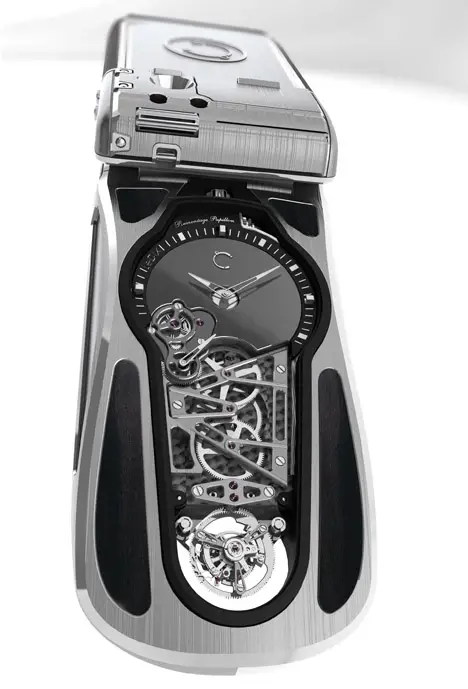
When LeDIX opens its wings, an attentive listener perceives a gentle noise that micromechanical devotees are sure to appreciate. It comes from the patented winding system of its horological component. Housed within the hinge, this Remontage Papillon (Butterfly Winding) is activated with each opening, thereby adding three hours of power reserve to the total 100 hours – a major innovation that elevates this nomadic object to an extraordinary, fusional dimension. This state-of-the-art communication device comprises a range of features that take micromechanics well beyond its usual boundaries, including: a mechanical battery-ejection system; a main connector protected by a mechanical-locking flap; and screen-flap closing cushioned by a set of spring-mounted ball bearings.
The electronic communication platform combines high performance with extreme reliability. Designed in collaboration with renowned French company, recognised as a global benchmark in the field of customised connected lifestyle devices, it embodies the most demanding quality standards. Its interface, which deliberately focuses on the essential mobile functions, makes LeDIX the ultimate personal phone, specifically designed for the pleasure of escaping from daily routine. This approach targeting durability, quality and simplicity involved a number of challenges, such as handling interferences with the moving watch components, or with the metal casing – itself a token of nobility and superior resistance. The fusion of haute horologerie with the world of mobile technology led to some innovative features, such as the mechanical whisper of time constantly accompanying every communication.
This revolutionary object comes complete with its very own ecosystem of accessories. “LeKit”: the no-hands kit secured by a tie-pin style clip, “LaBase”: the docking station. “LaChaîne”, the innovative chain system, and “LeCoffret”: the presentation box. They’ve been all devised and designed by Celsius X VI II. They are crafted in noble materials and equipped with mechanical components reflecting the brand’s fundamental concept. Leather items, such as “LeHolster”: the holster-type pouch, are made from top-quality hand-sewn hides. LeDix and its ecosystem herald a new and prestigious mechanical world…
LeDIX is available in two limited editions:
- LeDIX Origine, limited edition of 18 in grade 5 titanium with ebony inserts
- LeDIX Véloce, limited edition of 28 in black PVD-treated titanium with carbon fibre inserts
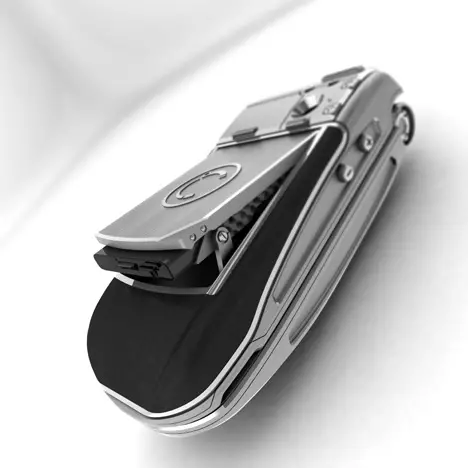
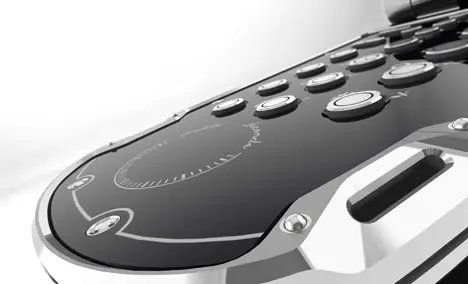
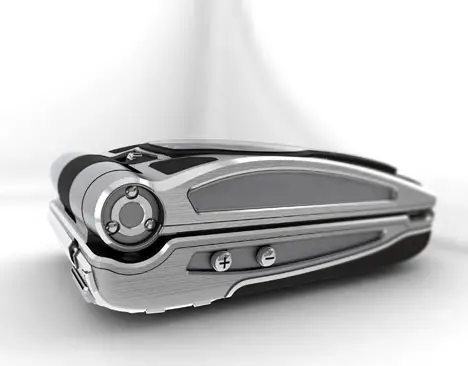
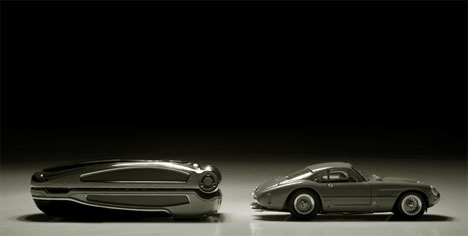
Phao cứu hộ điều khiển từ xa
Trên các bãi biển, thủy triều và biển động có thể kéo người đang bơi ra ngoài khơi cực nhanh. Lúc đó, các nhân viên cứu hộ không thể bơi ngay ra để cứu mà việc hạ thủy một chiếc ca nô cứu hộ lại rất mất thời gian.
Để giải quyết tình huống này, các kỹ sư ở Mỹ đã thiết kế một loại phao cứu sinh Emily rẻ tiền và dễ dàng tiếp cứu những người bị nạn. Loại phao này nặng khoảng 11 kg, hạ thủy chỉ mất 30 giây và có thể đạt tốc độ tối đa 39 km/giờ, có tần số radio điều khiển trong phạm vi 1,6 km, được tích hợp hệ thống quét dò tìm người bị nạn đã chìm xuống nước. * * Phát sáng từ bên trong cơ thể Các nhà sinh vật học của Viện Hải dương học Scripps (San Diego, Mỹ) đang nghiên cứu về loài ốc sên biển Clusterwink, có thể phát quang từ bên trong cơ thể để tránh kẻ thù (ảnh).
Loài ốc này nhỏ bé, thường thấy trong các cụm ốc dính chặt trên bờ đá ở bãi biển. Không giống như loài ốc sên trên cạn tiết ra chất nhầy phát quang, ốc Clusterwink phát quang sinh học dựa trên một phản ứng hóa học bên trong cơ thể chúng. Khi có sinh vật nào chạm vào, chúng sẽ phát ra một ánh sáng nhấp nháy màu xanh lá cây. Đặc biệt, ngay cả khi co vào, lớp vỏ của chúng vẫn có khả năng khuếch đại ánh sáng khiến nguồn sáng này tăng lên rất nhiều và tỏa ra mọi hướng trên vỏ. Do đó, chúng có thể liên lạc an toàn với nhau cả khi đã rúc vào bên trong lớp vỏ cứng. Cơ chế phát sáng độc đáo này không những tạo ra ảo giác nhằm làm cho kẻ thù phải hoảng sợ bỏ đi mà còn báo động cho những sinh vật săn mồi lớn hơn đến bắt kẻ thù. |
| Theo Người lao động |
Trimo Urban Crash – International Competition

International competition, Trimo Urban Crash, offers students and universities an excellent communication channel to efficiently establish contact, an opportunity for knowledge exchange, and comparison of different architectural approaches. Trimo Urban Crash is acompetition that encourages creative re-modelling of an urban environment with progressive construction materials and technologies, produced by Trimo, as an established European provider.
The experience of creating a solution for a potentially realizable project is also very important.Trimo strives to expand connections and cooperation with academia, to ensure diverse content for the syllabuses in Faculties of Architecture, and to encourage constructive cooperation between theory, practice, and economics, in different areas. Considering the strong tradition of Trimo’s research development department, and the focus on a professional approach, Trimo Urban Crash is one of many innovative projects.
Trimo received almost 150 projects, submitted from 17 countries, in the previous 2008/2009 competition. The winning project was that of a cultural stage with the characteristics of an urban sculpture, submitted by Polish students.
Designeast.eu
"Tvor": Perhaps the world's most existential lamp

The "Tvor" lamp by Czech design student Jindrich Vodicka, is another example of the weird and wonderful creations to emerge from the maturing design scene in central and eastern Europe in recent years.
This bizarre concept, uses sensors and an Adruino programme to scan its immediate environment to locate the darkest patch—which it then leaps into action to flood with light. Unfortunately, the creation is "doomed to endless travel" as it eagerness to illuminate only transfers the darkness to another part of the room—starting the whole process again.

(via Designeast)


